The Relationship between Motor Coordination and Imitation: An fNIRS Study
Abstract
1. Introduction
2. Materials and Methods
2.1. Subjects
2.2. Stimuli
2.2.1. Imitation Task
2.2.2. Motor Coordination Test—Harre Circuit Test (HCT)
2.3. Procedure
2.4. fNIRS Data Acquisition
2.5. Data Processing and Analysis
2.5.1. Behavioral Data Processing
2.5.2. fNIRS Data Processing and Analysis
2.5.3. Statistical Analysis
3. Results
3.1. Behavioral Results
3.2. Correlation Test between Imitation and Activation of Region of Interest (ROI)
3.3. The Moderating Effect of Motor Coordination
4. Discussion
5. Conclusions
Author Contributions
Funding
Institutional Review Board Statement
Informed Consent Statement
Data Availability Statement
Acknowledgments
Conflicts of Interest
References
- Jones, S.S. The Development of Imitation in Infancy. Philos. Trans. R Soc. Lond. B Biol. Sci. 2009, 364, 2325–2335. [Google Scholar] [CrossRef]
- Brass, M.; Heyes, C. Imitation: Is Cognitive Neuroscience Solving the Correspondence Problem? Trends Cogn. Sci. 2005, 9, 489–495. [Google Scholar] [CrossRef] [PubMed]
- Santner, A.; Kopp, M.; Federolf, P. Partly Randomised, Controlled Study in Children Aged 6–10 Years to Investigate Motor and Cognitive Effects of a 9-Week Coordination Training Intervention with Concurrent Mental Tasks. BMJ Open 2018, 8, e021026. [Google Scholar] [CrossRef] [PubMed]
- Piek, J.P.; Dyck, M.J.; Nieman, A.; Anderson, M.; Hay, D.; Smith, L.M.; McCoy, M.; Hallmayer, J. The Relationship between Motor Coordination, Executive Functioning and Attention in School Aged Children. Arch. Clin. Neuropsychol. 2004, 19, 1063–1076. [Google Scholar] [CrossRef] [PubMed]
- Festante, F.; Vanderwert, R.E.; Sclafani, V.; Paukner, A.; Simpson, E.A.; Suomi, S.J.; Fox, N.A.; Ferrari, P.F. Eeg Beta Desynchronization During Hand Goal-Directed Action Observation in Newborn Monkeys and Its Relation to the Emergence of Hand Motor Skills. Dev. Cogn. Neurosci. 2018, 30, 142–149. [Google Scholar] [CrossRef]
- Rizzolatti, G.; Luppino, G. The Cortical Motor System. Neuron 2001, 31, 889–901. [Google Scholar] [CrossRef]
- Reynolds, J.E.; Billington, J.; Kerrigan, S.; Williams, J.; Elliott, C.; Winsor, A.M.; Codd, L.; Bynevelt, M.; Licari, M.K. Mirror Neuron System Activation in Children with Developmental Coordination Disorder: A Replication Functional Mri Study. Res. Dev. Disabil. 2019, 84, 16–27. [Google Scholar] [CrossRef]
- Aziz-Zadeh, L.; Koski, L.; Zaidel, E.; Mazziotta, J.; Iacoboni, M. Lateralization of the Human Mirror Neuron System. J. Neurosci. 2006, 26, 2964–2970. [Google Scholar] [CrossRef]
- Decety, J. The Neurophysiological Basis of Motor Imagery. Behav. Brain Res. 1996, 77, 45–52. [Google Scholar] [CrossRef]
- Grafton, S.T.; Arbib, M.A.; Fadiga, L.; Rizzolatti, G. Localization of Grasp Representations in Humans by Positron Emission Tomography. 2. Observation Compared with Imagination. Exp. Brain Res. 1996, 112, 103–111. [Google Scholar] [CrossRef]
- de C Hamilton, A.F. The Neurocognitive Mechanisms of Imitation. Curr. Opin. Behav. Sci. 2015, 3, 63–67. [Google Scholar] [CrossRef]
- Reynolds, J.E.; Thornton, A.L.; Elliott, C.; Williams, J.; Lay, B.S.; Licari, M.K. A Systematic Review of Mirror Neuron System Function in Developmental Coordination Disorder: Imitation, Motor Imagery, and Neuroimaging Evidence. Res. Dev. Disabil. 2015, 47, 234–283. [Google Scholar] [CrossRef] [PubMed]
- Perrey, S. Non-Invasive Nir Spectroscopy of Human Brain Function During Exercise. Methods 2008, 45, 289–299. [Google Scholar] [CrossRef] [PubMed]
- Scholkmann, F.; Kleiser, S.; Metz, A.J.; Zimmermann, R.; Pavia, J.M.; Wolf, U.; Wolf, M. A Review on Continuous Wave Functional near-Infrared Spectroscopy and Imaging Instrumentation and Methodology. Neuroimage 2014, 85 Pt 1, 6–27. [Google Scholar] [CrossRef]
- Agbangla, N.F.; Audiffren, M.; Albinet, C.T. Use of near-Infrared Spectroscopy in the Investigation of Brain Activation During Cognitive Aging: A Systematic Review of an Emerging Area of Research. Ageing Res. Rev. 2017, 38, 52–66. [Google Scholar] [CrossRef]
- Makuuchi, M. Is Broca’s Area Crucial for Imitation? Cereb. Cortex 2005, 15, 563–570. [Google Scholar] [CrossRef][Green Version]
- Pizzamiglio, G.; Zhang, Z.; Kolasinski, J.; Riddoch, J.M.; Passingham, R.E.; Mantini, D.; Rounis, E. A Role for the Action Observation Network in Apraxia after Stroke. Front. Hum. Neurosci. 2019, 13, 422. [Google Scholar] [CrossRef]
- Cohen, N.R.; Pomplun, M.; Gold, B.J.; Sekuler, R. Sex Differences in the Acquisition of Complex Skilled Movements. Exp. Brain Res. 2010, 205, 183–193. [Google Scholar] [CrossRef]
- Cracco, E.; De Coster, L.; Andres, M.; Brass, M. Mirroring Multiple Agents: Motor Resonance During Action Observation Is Modulated by the Number of Agents. Soc. Cogn. Affect. Neurosci. 2016, 11, 1422–1427. [Google Scholar] [CrossRef]
- Halsband, U.; Schmitt, J.; Weyers, M.; Binkofski, F.; Grutzner, G.; Freund, H.J. Recognition and Imitation of Pantomimed Motor Acts after Unilateral Parietal and Premotor Lesions: A Perspective on Apraxia. Neuropsychologia 2001, 39, 200–216. [Google Scholar] [CrossRef]
- Kruger, B.; Bischoff, M.; Blecker, C.; Langhanns, C.; Kindermann, S.; Sauerbier, I.; Reiser, M.; Stark, R.; Munzert, J.; Pilgramm, S. Parietal and Premotor Cortices: Activation Reflects Imitation Accuracy During Observation, Delayed Imitation and Concurrent Imitation. Neuroimage 2014, 100, 39–50. [Google Scholar] [CrossRef]
- Alesi, M.; Bianco, A.; Padulo, J.; Vella, F.P.; Petrucci, M.; Paoli, A.; Palma, A.; Pepi, A. Motor and Cognitive Development: The Role of Karate. Muscles Ligaments Tendons J. 2014, 4, 114–120. [Google Scholar] [CrossRef] [PubMed]
- Alesi, M.; Bianco, A.; Padulo, J.; Luppina, G.; Petrucci, M.; Paoli, A.; Palma, A.; Pepi, A. Motor and Cognitive Growth Following a Football Training Program. Front. Psychol. 2015, 6, 1627. [Google Scholar] [CrossRef] [PubMed]
- Ye, J.C.; Tak, S.; Jang, K.E.; Jung, J.; Jang, J. Nirs-Spm: Statistical Parametric Mapping for near-Infrared Spectroscopy. Neuroimage 2009, 44, 428–447. [Google Scholar] [CrossRef] [PubMed]
- WHO. Obesity: Preventing and Managing the Global Epidemic; Report of a Who Consultation on Obesity; WHO: Geneva, Switzerland, 2000. [Google Scholar]
- Kamandulis, S.; Venckunas, T.; Masiulis, N.; Matulaitis, K.; Balciunas, M.; Peters, D.; Skurvydas, A. Relationship between General and Specific Coordination in 8- to 17-Year-Old Male Basketball Players. Percept. Mot. Skills 2013, 117, 821–836. [Google Scholar] [CrossRef]
- Xu, Z.; Wang, Z.R.; Li, J.; Hu, M.; Xiang, M.Q. Effect of Acute Moderate-Intensity Exercise on the Mirror Neuron System: Role of Cardiovascular Fitness Level. Front. Psychol. 2020, 11, 312. [Google Scholar] [CrossRef]
- Kiyama, S.; Kunimi, M.; Iidaka, T.; Nakai, T. Distant Functional Connectivity for Bimanual Finger Coordination Declines with Aging: An Fmri and Sem Exploration. Front. Hum. Neurosci. 2014, 8, 251. [Google Scholar] [CrossRef]
- Bhattacharjee, S.; Kashyap, R.; Abualait, T.; Annabel Chen, S.H.; Yoo, W.K.; Bashir, S. The Role of Primary Motor Cortex: More Than Movement Execution. J. Mot. Behav. 2021, 53, 258–274. [Google Scholar] [CrossRef]
- Sun, P.P.; Tan, F.L.; Zhang, Z.; Jiang, Y.H.; Zhao, Y.; Zhu, C.Z. Feasibility of Functional near-Infrared Spectroscopy (Fnirs) to Investigate the Mirror Neuron System: An Experimental Study in a Real-Life Situation. Front. Hum. Neurosci. 2018, 12, 86. [Google Scholar] [CrossRef] [PubMed]
- Strangman, G.; Boas, D.A.; Sutton, J.P. Non-invasive neuroimaging using near-infrared light. Biol. Psychiatry 2002, 52, 679–693. [Google Scholar] [CrossRef]
- Yanagisawa, H.; Dan, I.; Tsuzuki, D.; Kato, M.; Okamoto, M.; Kyutoku, Y.; Soya, H. Acute moderate exercise elicits increased dorsolateral prefrontal activation and improves cognitive performance with Stroop test. Neuroimage 2010, 50, 1702–1710. [Google Scholar] [CrossRef] [PubMed]
- Cheng, X.; Li, X.; Hu, Y. Synchronous brain activity during cooperative exchange depends on gender of partner: A fNIRS-based hyperscanning study. Hum. Brain Mapp. 2015, 36, 2039–2048. [Google Scholar] [CrossRef] [PubMed]
- Koehler, S.; Egetemeir, J.; Stenneken, P.; Koch, S.P.; Pauli, P.; Fallgatter, A.J.; Herrmann, M.J. The human execution/observation matching system investigated with a complex everyday task: A functional near-infrared spectroscopy (fNIRS) study. Neurosci. Lett. 2012, 508, 73–77. [Google Scholar] [CrossRef] [PubMed]
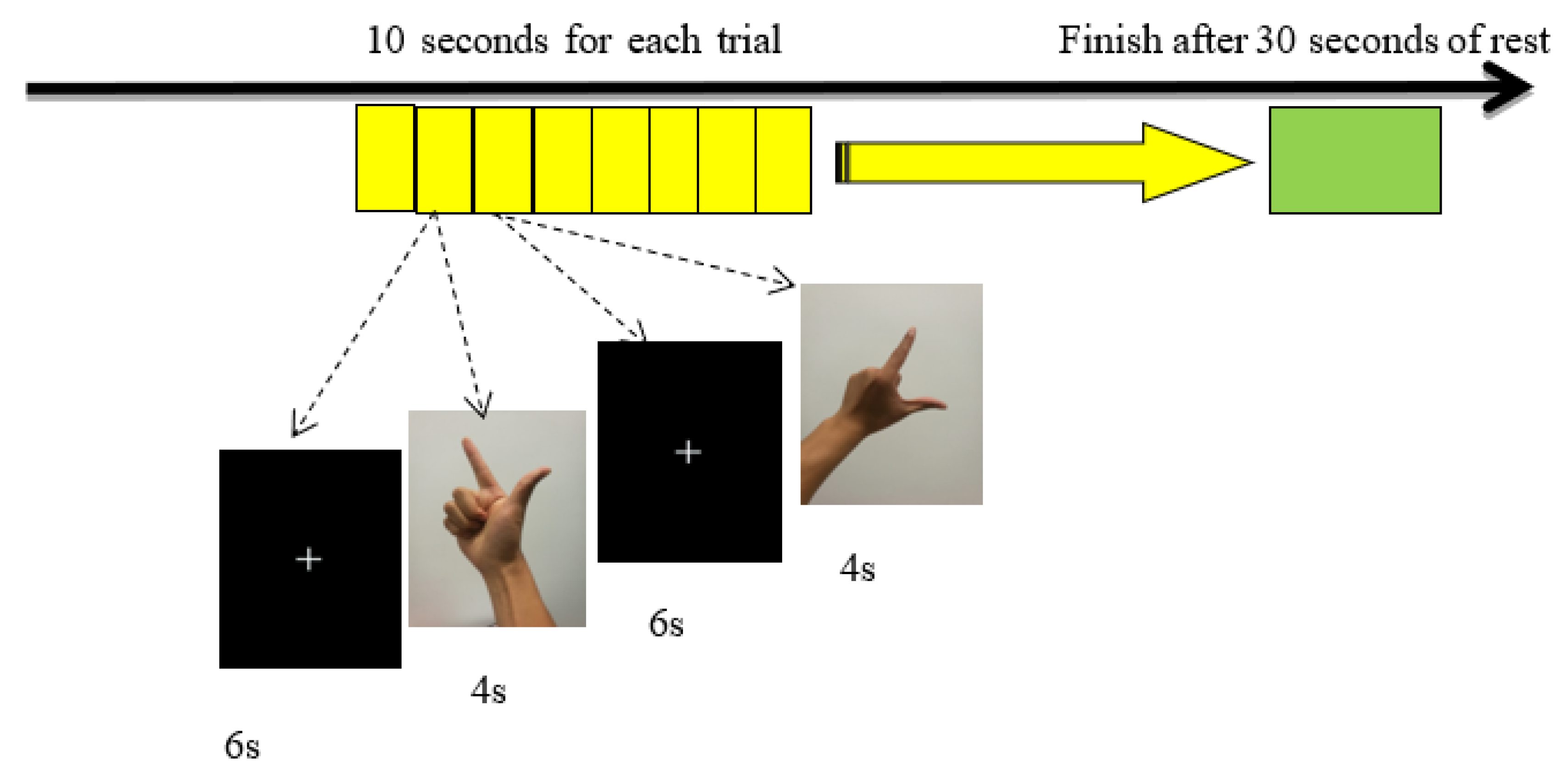
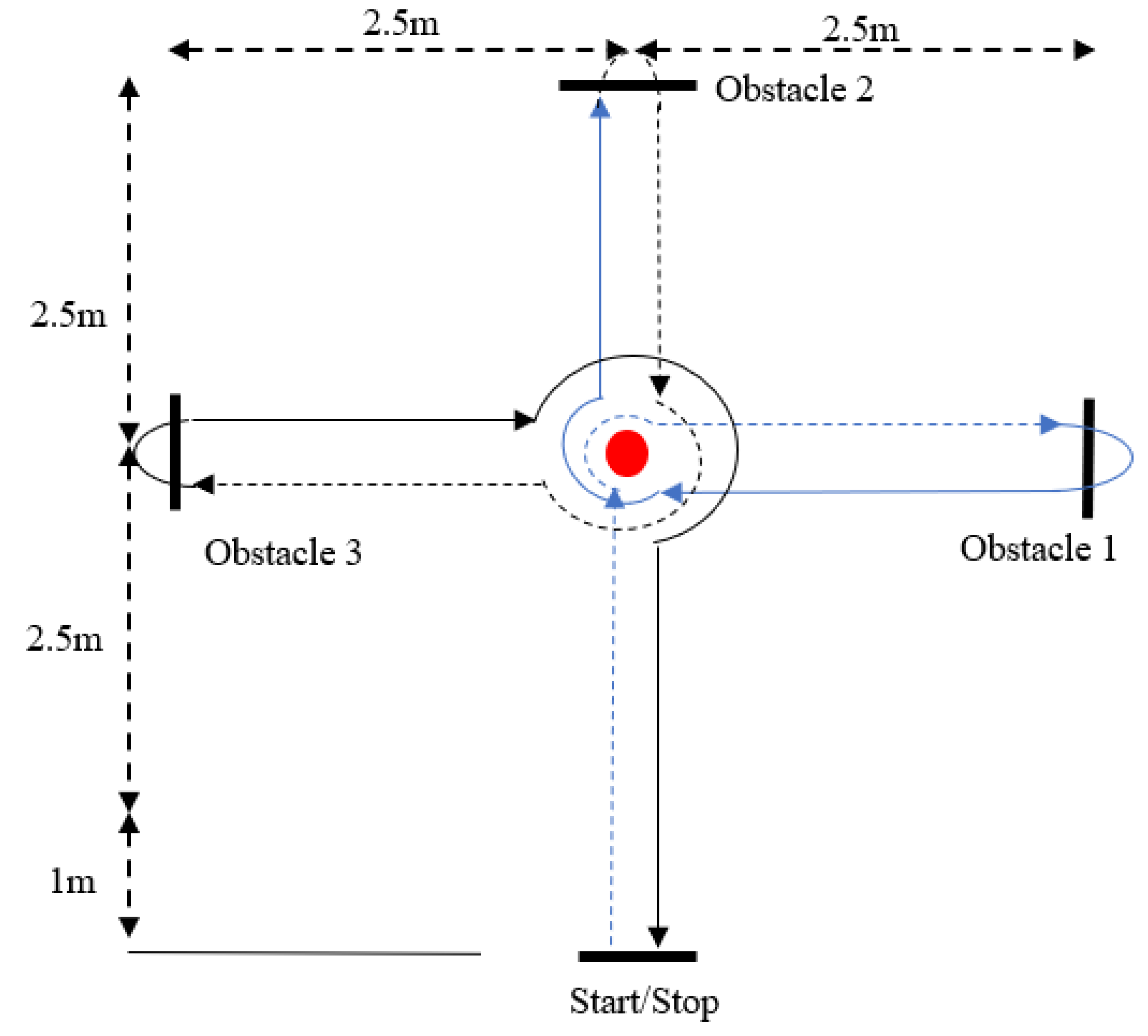

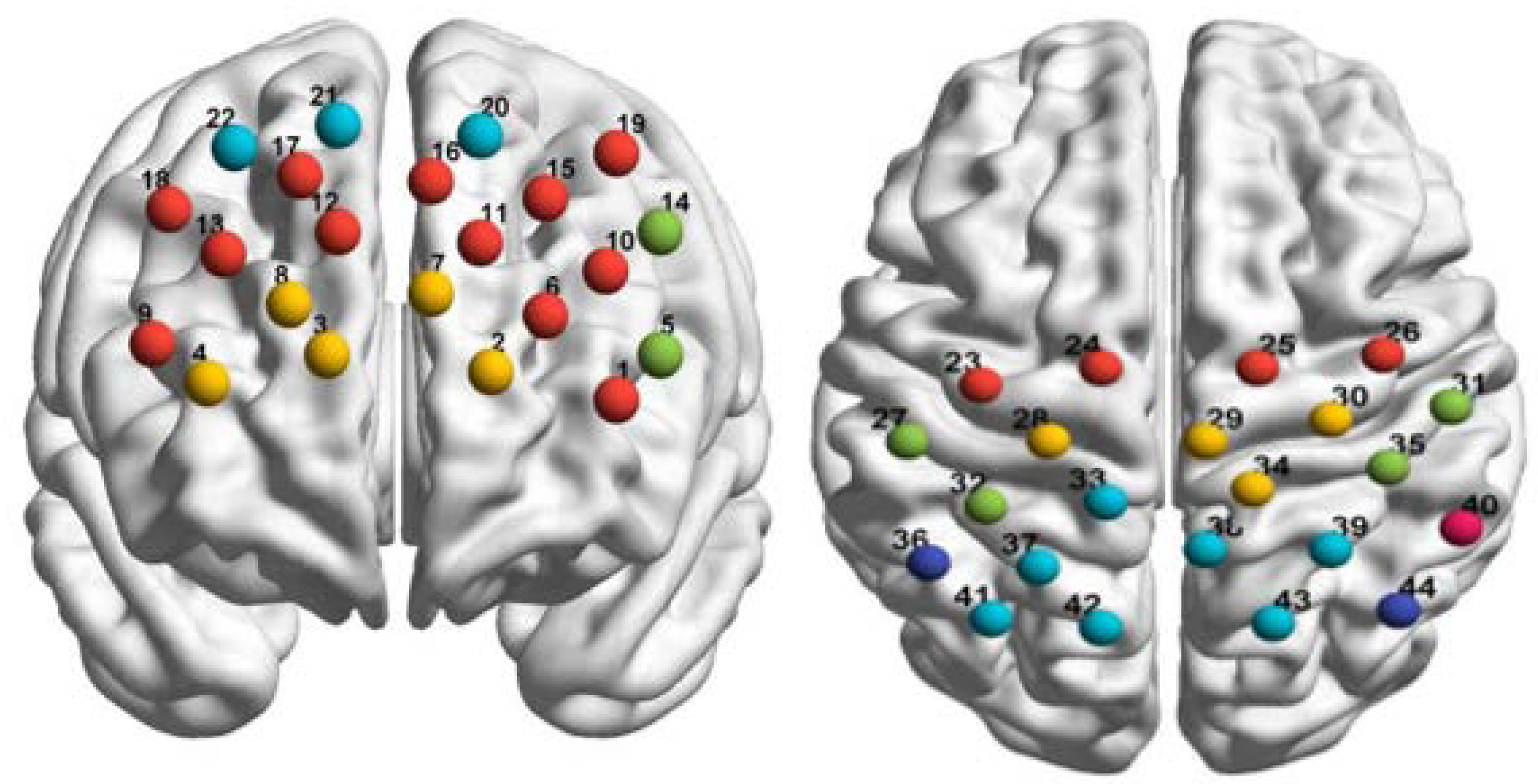

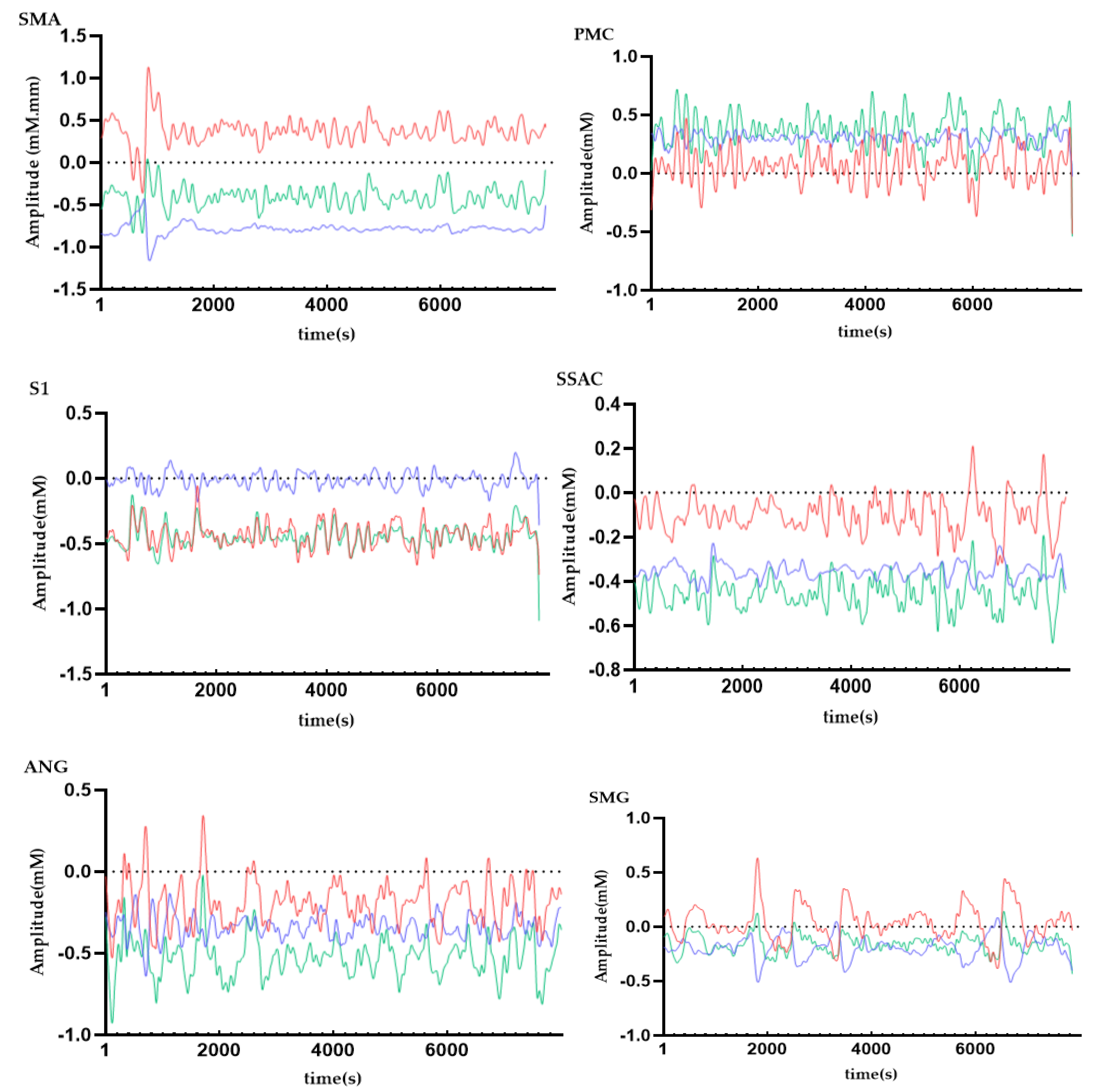
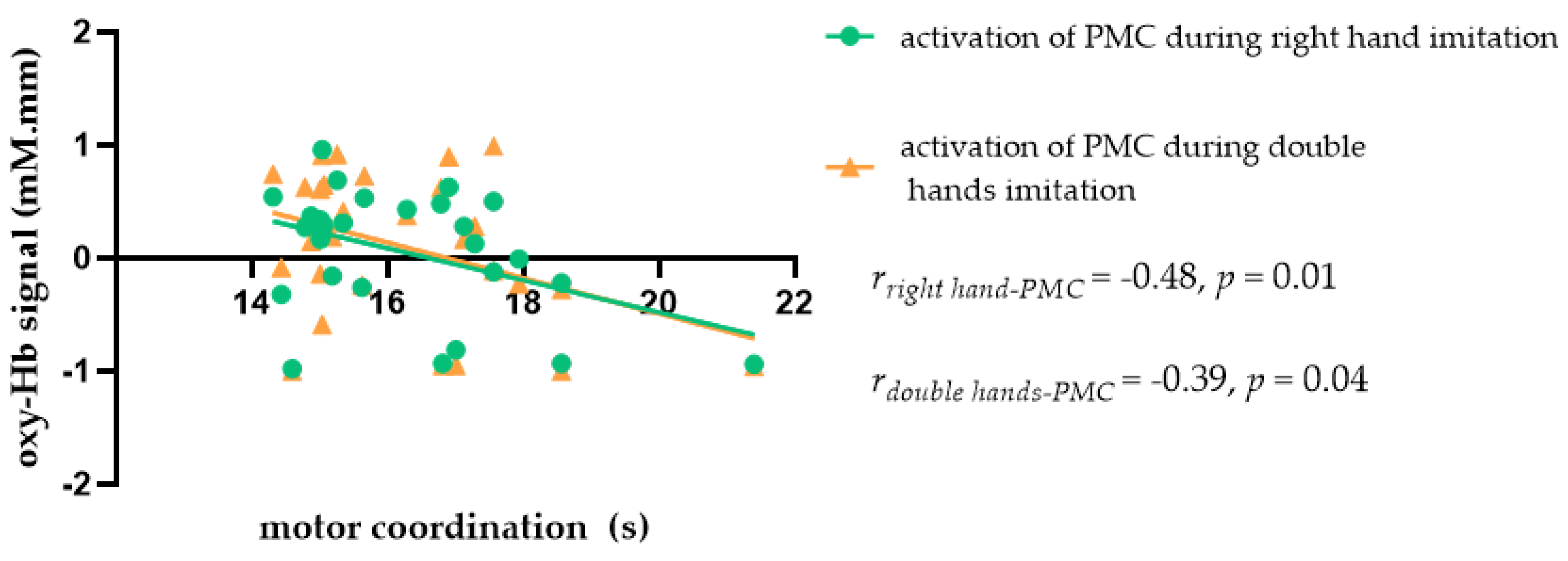
| Variables | Male (N = 18) | Female (N = 28) | Total (N = 46) |
|---|---|---|---|
| Age (years) | 19.44 ± 0.51 | 19.64 ± 0.95 | 19.57 ± 0.81 |
| Height (cm) | 178.17 ± 6.95 | 161.36 ± 4.50 | 167.93 ± 9.96 |
| Weight (kg) | 72.56 ± 11.69 | 54.71 ± 5.82 | 61.70 ± 12.22 |
| BMI (kg/m2) | 21.77 ± 2.72 | 20.99 ± 1.80 | 21.69 ± 2.35 |
| Behavioral Indicators | Male (N = 18) | Female (N = 28) | Total (N = 46) |
|---|---|---|---|
| Motor coordination(s) | 14.74 ± 1.47 | 16.25 ± 1.63 | 16.66 ± 1.72 |
| Imitation ability | |||
| Accuracy in right hand trials (%) | 98.47 ± 2.12 | 99.26 ± 1.96 | 98.95 ± 2.04 |
| Average time in right hand trials (ms) | 2583.798 ± 504.22 | 2558.56 ± 407.93 | 2568.43 ± 442.77 |
| Accuracy in left hand trials (%) | 97.72 ± 2.81 | 97.89 ± 4.01 | 97.82 ± 3.55 |
| Average time in left hand trials (ms) | 2745.00 ± 511.56 | 2750.41 ± 423.64 | 2748.29 ± 454.48 |
| Accuracy in double hand trials (%) | 96.30 ± 5.39 | 97.62 ± 5.54 | 97.10 ± 5.46 |
| Average time in double hand trials (ms) | 2745.23 ± 537.31 | 1749.60 ± 497.50 | 2747.89 ± 507.52 |
| ROI | Right Hand Imitation | Left Hand Imitation | Double Hand Imitation |
|---|---|---|---|
| SMA | −0.37 * | −0.42 * | −0.52 ** |
| PMC | −0.46 * | −0.27 | −0.41 * |
| S1 | −0.40 * | −0.50 ** | −0.53 ** |
| SSAC | −0.35 | −0.31 | −0.48 * |
| ANG | −0.43 * | −0.45 * | −0.46 * |
| SMG | −0.36 | −0.47 * | −0.56 ** |
| Independent Variable | Effect | t | 95%CI | p | |
|---|---|---|---|---|---|
| PMC activation during right hand imitation trials | Mean − 1SD | −463.89 | −2.71 | [−816.94, −110.84] | 0.01 |
| Mean | −200.05 | −1.52 | [−472.20, 72.10] | 0.14 | |
| Mean + 1SD | 63.79 | 0.34 | [−317.46, 445.04] | 0.73 | |
| S1 activation during right hand imitation trials | Mean − 1SD | −459.20 | −2.80 | [−797.91, −120.49] | 0.01 |
| Mean | −249.84 | −2.14 | [−490.42, −9.27] | 0.04 | |
| Mean + 1SD | −40.49 | −0.29 | [−327.59, 246.62] | 0.77 | |
| SMA activation during left hand imitation trials | Mean − 1SD | −1191.12 | −3.22 | [−1953.96, −428.27] | 0.004 |
| Mean | −802.73 | −3.11 | [−1335.86, −269.60] | 0.005 | |
| Mean + 1SD | −414.34 | −1.96 | [−850.35, 21.67] | 0.06 | |
| S1 activation during left hand imitation trials | Mean − 1SD | −617.88 | −3.62 | [−969.98, −265.77] | 0.001 |
| Mean | −373.91 | −3.16 | [−618.19, −129.63] | 0.004 | |
| Mean + 1SD | −129.94 | −0.97 | [−406.15, 146.26] | 0.34 | |
| ANG activation during left hand imitation trials | Mean − 1SD | −1059.95 | −5.82 | [−1435.94, −683.96] | 0.001 |
| Mean | −421.16 | −2.85 | [−725.73, −116.59] | 0.01 | |
| Mean + 1SD | 217.63 | 0.82 | [−327.96, 763.22] | 0.42 | |
| PMC activation during left hand imitation trials | Mean − 1SD | −535.90 | −3.55 | [−847.32, −224.47] | 0.002 |
| Mean | −255.04 | −2.06 | [−510.67, 0.59] | 0.05 | |
| Mean + 1SD | 25.81 | 0.14 | [−368.85, 420.47] | 0.89 | |
| SMG activation during left hand imitation trials | Mean − 1SD | −1150.46 | −4.83 | [−1641.47, −659.25] | 0.001 |
| Mean | −716.24 | −4.41 | [−1051.45, −381.03] | 0.002 | |
| Mean + 1SD | −282.12 | −1.58 | [−651.15, 86.90] | 0.13 | |
| PMC activation during double hand imitation trials | Mean − 1SD | −469.85 | −2.71 | [−827.96, −111.74] | 0.01 |
| Mean | −191.51 | −1.55 | [−447.26, −64.24] | 0.13 | |
| Mean + 1SD | 86.82 | 0.52 | [−259.51, 433.16] | 0.52 | |
| S1 activation during double hand imitation trials | Mean − 1SD | −469.85 | −2.71 | [−827.96, −111.74] | 0.01 |
| Mean | −191.51 | −1.55 | [−447.26, 64.24] | 0.13 | |
| Mean + 1SD | 86.82 | 0.52 | [−259.51, 433.16] | 0.61 |
Publisher’s Note: MDPI stays neutral with regard to jurisdictional claims in published maps and institutional affiliations. |
© 2021 by the authors. Licensee MDPI, Basel, Switzerland. This article is an open access article distributed under the terms and conditions of the Creative Commons Attribution (CC BY) license (https://creativecommons.org/licenses/by/4.0/).
Share and Cite
Zhao, W.; Hui, M.; Zhang, X.; Li, L. The Relationship between Motor Coordination and Imitation: An fNIRS Study. Brain Sci. 2021, 11, 1052. https://doi.org/10.3390/brainsci11081052
Zhao W, Hui M, Zhang X, Li L. The Relationship between Motor Coordination and Imitation: An fNIRS Study. Brain Sciences. 2021; 11(8):1052. https://doi.org/10.3390/brainsci11081052
Chicago/Turabian StyleZhao, Wenrui, Minqiang Hui, Xiaoyou Zhang, and Lin Li. 2021. "The Relationship between Motor Coordination and Imitation: An fNIRS Study" Brain Sciences 11, no. 8: 1052. https://doi.org/10.3390/brainsci11081052
APA StyleZhao, W., Hui, M., Zhang, X., & Li, L. (2021). The Relationship between Motor Coordination and Imitation: An fNIRS Study. Brain Sciences, 11(8), 1052. https://doi.org/10.3390/brainsci11081052





